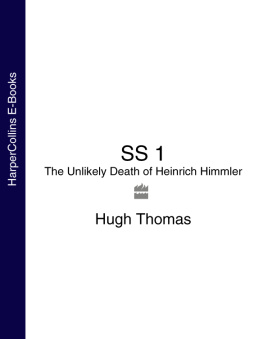HEINRICH HIMMLER
HEINRICH HIMMLER
PETER LONGERICH
TRANSLATED BY
JEREMY NOAKES
AND
LESLEY SHARPE

OXFORD
UNIVERSITY PRESS
Great Clarendon Street, Oxford OX2 6DP
Oxford University Press is a department of the University of Oxford.
It furthers the Universitys objective of excellence in research, scholarship,
and education by publishing worldwide in
Oxford New York
Auckland Cape Town Dar es Salaam Hong Kong Karachi
Kuala Lumpur Madrid Melbourne Mexico City Nairobi
New Delhi Shanghai Taipei Toronto
With offices in
Argentina Austria Brazil Chile Czech Republic France Greece
Guatemala Hungary Italy Japan Poland Portugal Singapore
South Korea Switzerland Thailand Turkey Ukraine Vietnam
Oxford is a registered trade mark of Oxford University Press
in the UK and in certain other countries
Published in the United States
by Oxford University Press Inc., New York
Peter Longerich, 2012
First published as Himmler: Bibliographie
by Siedler Verlag Peter Longerich, 2008
The moral rights of the author have been asserted
Database right Oxford University Press (maker)
First published 2012
All rights reserved. No part of this publication may be reproduced,
stored in a retrieval system, or transmitted, in any form or by any means,
without the prior permission in writing of Oxford University Press,
or as expressly permitted by law, or under terms agreed with the appropriate
reprographics rights organization. Enquiries concerning reproduction
outside the scope of the above should be sent to the Rights Department,
Oxford University Press, at the address above
You must not circulate this book in any other binding or cover
and you must impose the same condition on any acquirer
British Library Cataloguing in Publication Data
Data available
Library of Congress Cataloging in Publication Data
Data available
Typeset by SPI Publisher Services, Pondicherry, India
Printed in Great Britain
on acid-free paper by
Clays Ltd, St Ives plc
ISBN 9780199592326
1 3 5 7 9 10 8 6 4 2
Acknowledgements
This book was written, with interruptions from other publications, over the last ten years and in various places: in London and Munich, in Washington, Frankfurt, and Essen, as well as almost everywhere I spent time during those years.
First and foremost, I should like to thank my colleagues and students at Royal Holloway College, University of London, who were once again willing to enable me to complete this work by generously allowing me periods of research. A series of research institutes gave me vital support by granting scholarships and visiting fellowships that provided the opportunity to discuss my work with others: the Center for Advanced Holocaust Studies at the US Holocaust Memorial Museum, the Fritz Bauer Institute in Frankfurt, and the Cultural Studies Institute in Essen.
In addition, in the last few years I have had the opportunity of presenting my work as it developed at a number of universities, in particular Freiburg, Stanford, Exeter, Oxford, and London (German History Seminar), also at the Villa Ten Hompel in Mnster, at the Wewelsburg Documentation Centre, and at the Imperial War Museum.
I was also able to have intensive discussions about Himmlers personality with a group of psychoanalysts in Hamburg and a circle of psychotherapists in Cologne; the discussions with both groups made a distinct and lasting impact on my work on Himmler. I should like to thank all those who took part in these gatherings: Christiane Adam, Sabine Brckner-Jungjohann, Petra Demleux-Morawietz, Gundula Fromm, Beata Hammerich, Ulrich Knocke, Dr Brbel Kreidt, Rita Krull-Wittkopf, Johannes Pfafflin, Dr Peter Pogany-Wnendt, Erda Siebert, Dirk Sieveking, Dr Bernd Sonntag, and Matthias Wellershoff.
Dr Andreas Kunz, director of the branch of the Federal Archive in Ludwigsburg, drew my attention to the memoirs of Colonel Eismann, Himmlers military colleague on the staff of the Army Group Vistula. Mrs Christa Schmeisser, in the head administrative office of the Bavarian Archives, obtained for me a transcription of Himmlers diaries and part of his correspondence. Mr Alois Schmidmeier helped me to decipher a number of shorthand passages in Himmlers letters. I am grateful to him as well as to all the staff of all the various archives and institutions that have supported my work.
P.L
Munich and London
July 2008
Contents
Note on Sources
The primary sources for this biography are scattered across archives in several countries. Thus there are personal documents of Himmlers in the Bundesarchiv [Federal Archive] in Koblenz, in the Hoover Library in Stanford, California, and in the Special Archive in Moscow. Margarethe Himmlers diary, which provides insights into their marriage, and several family photograph albums have for some years been accessible to researchers in the US Holocaust Museum in Washington, DC. Some of Himmlers private papers are in the hands of various individuals and are continually being offered for sale in auction houses. It is, however, extremely unlikely that further material of Himmlers will come to light that provides significant insights into his political actions.
The Bundesarchiv in Berlin contains over 4,000 files of the Personal Staff of the Reichsfhrer-SS and varying quantities of material from the SS main offices. The collection of the personal files of SS leaders in the former Berlin Document Center (now part of the Bundesarchiv, Berlin) not only contains valuable information about their careers but, in some cases, substantial correspondence with Himmler and his personal staff. I have used several hundred of these files for this book.
The Munich archives proved very productive for Himmlers early years. The files of the Nazi Partys Reich propaganda headquarters in the Bundesarchiv, Berlin contain extensive correspondence of Himmler, who ran this office from 1926 to 1930 as its deputy head.
Finally, his activities are revealed in the files of a large number of other institutions, for example in those of the Foreign Ministry, which are held in its political archive in Berlin, in the documents of military agencies (Bundesarchiv, Freiburg), in those of various party and state agencies (Bundesarchiv, Berlin), but also in the files of British institutions, which are in the Public Record Office in London [now the National Archives].
As far as possible I have consulted the original documents in the relevant archives. However, I was obliged to make a few exceptions: in some cases I have used copies of SS files from the Bundesarchiv in Berlin, which are available in the National Archives in Washington, DC, and used their reference numbers because trying to access these files in Berlin proved too time-consuming. In a number of cases I have also used copies of documents I was able to make during a lengthy stay in Yad Vashem in 19956. The originals are held in other archives.
The most important of the published sources is Heinrich Himmlers Office Diary 1941/42, which was edited by eight German historians. In an exemplary pioneering project, covering the particularly critical years 19412, they combined Himmlers hitherto undiscovered appointment notes, which were held in the Moscow Special Archive, with the Himmler calendars which were already available, and drew upon the Reichsfhrers correspondence contained in various collections of files in order to provide a context for the diary entries. In the process they have provided an indispensable source.










